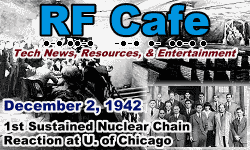|
  December 2 December 2
1594: Flemish cartographer
Gerardus
Mercator, developer of the map projection that bears his name, died. 1877:
Louis-Paul Cailletet became the first to liquefy oxygen. 1881:
German physicist Heinrich Barkhausen, who discovered the effect named after him
regarding changes in the magnetic properties of metal, was born. 1895: James Dewar
exhibited his new apparatus for the production of liquefied air. 1906:
Peter
Goldmark, who developed the first color commercial television system as well
as the 33-1/3 LP phonograph record, was born. 1927: The first Model A Fords sold
for $385. 1941: Admiral Yamamoto ordered his fleet to Pearl Harbor. 1942: A self-sustaining
nuclear chain reaction was demonstrated by
Dr. Enrico Fermi and his staff at the University of Chicago. 1952:
The first human birth was televised to public on KOA-TV. 1965: American physicist
Hugh Dryden,
who headed NACA (now NASA) for seven years and after whom the
Dryden Flight Research Center is named, died. 1983: Over 40
tons of highly poisonous methyl isocyanate gas leaked out of the Union
Carbide pesticide factory in
Bhopal, India, killing thousands of souls. 1990: The first
parliamentary election was held in newly
reunified Germany. 2001:
Enron filed
for Chapter 11 bankruptcy.
| Jan
| Feb | Mar |
Apr | May |
Jun | Jul |
Aug | Sep |
Oct | Nov |
Dec |
Note: These
historical tidbits have been collected from various sources, mostly on the Internet.
As detailed in
this article, there
is a lot of wrong information that is repeated hundreds of times because most websites
do not validate with authoritative sources. On RF Cafe, events with
hyperlinks have been verified. Many years ago,
I began commemorating the birthdays of notable people and events with
special RF Cafe logos.
Where available, I like to use images from postage stamps from the country where
the person or event occurred. Images used in the logos are often from open source
websites like Wikipedia, and are specifically credited with a hyperlink back to
the source where possible.
Fair Use laws permit
small samples of copyrighted content.
|










